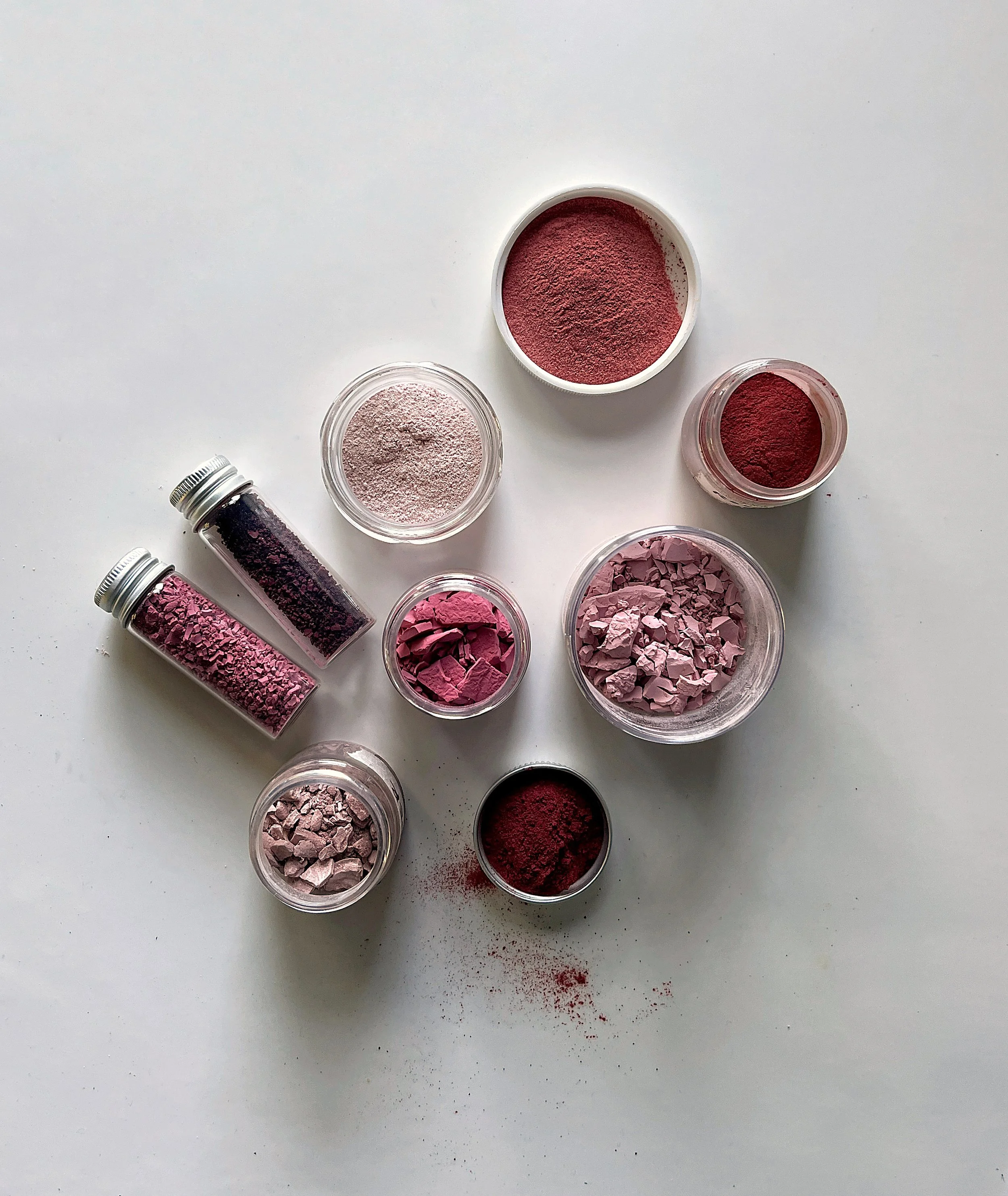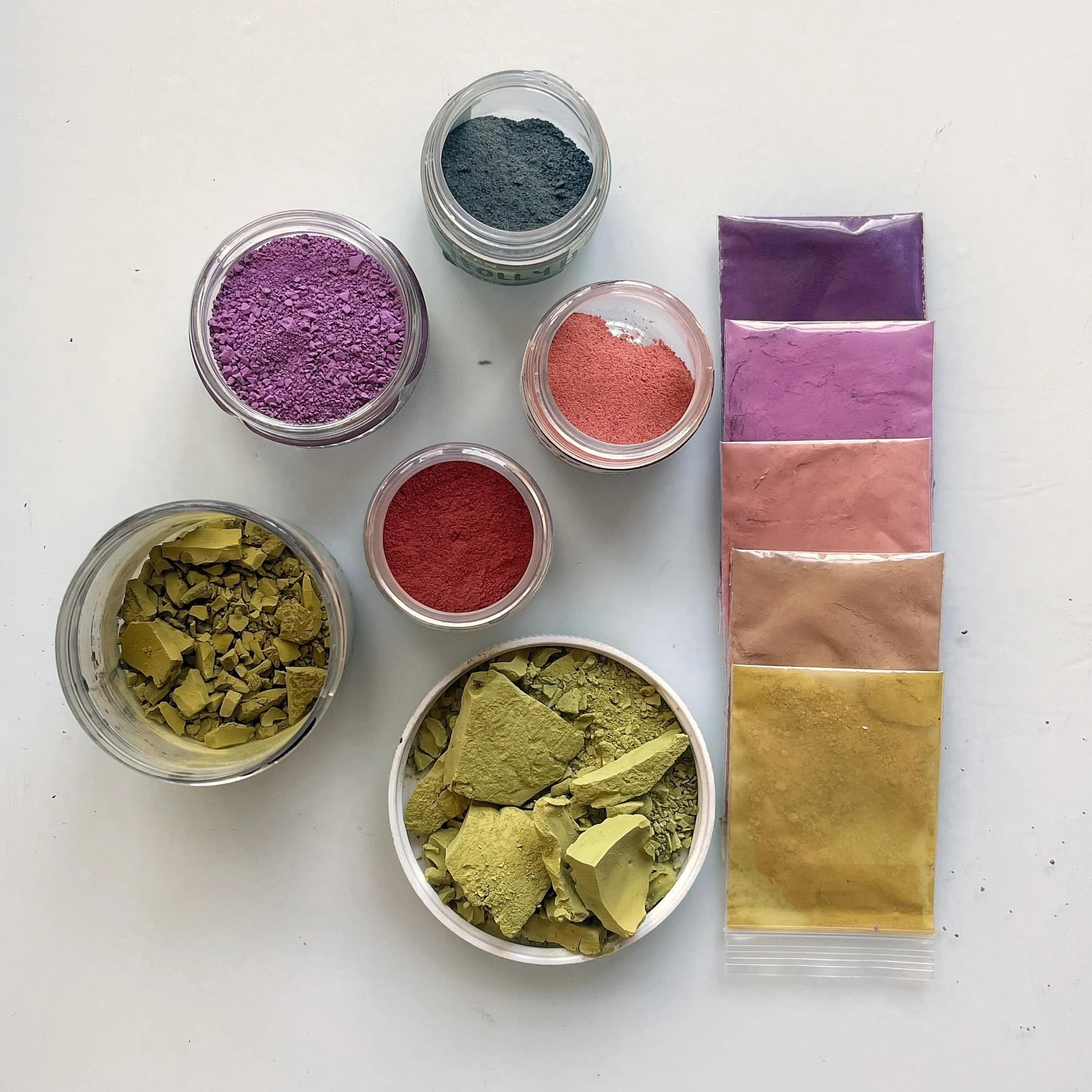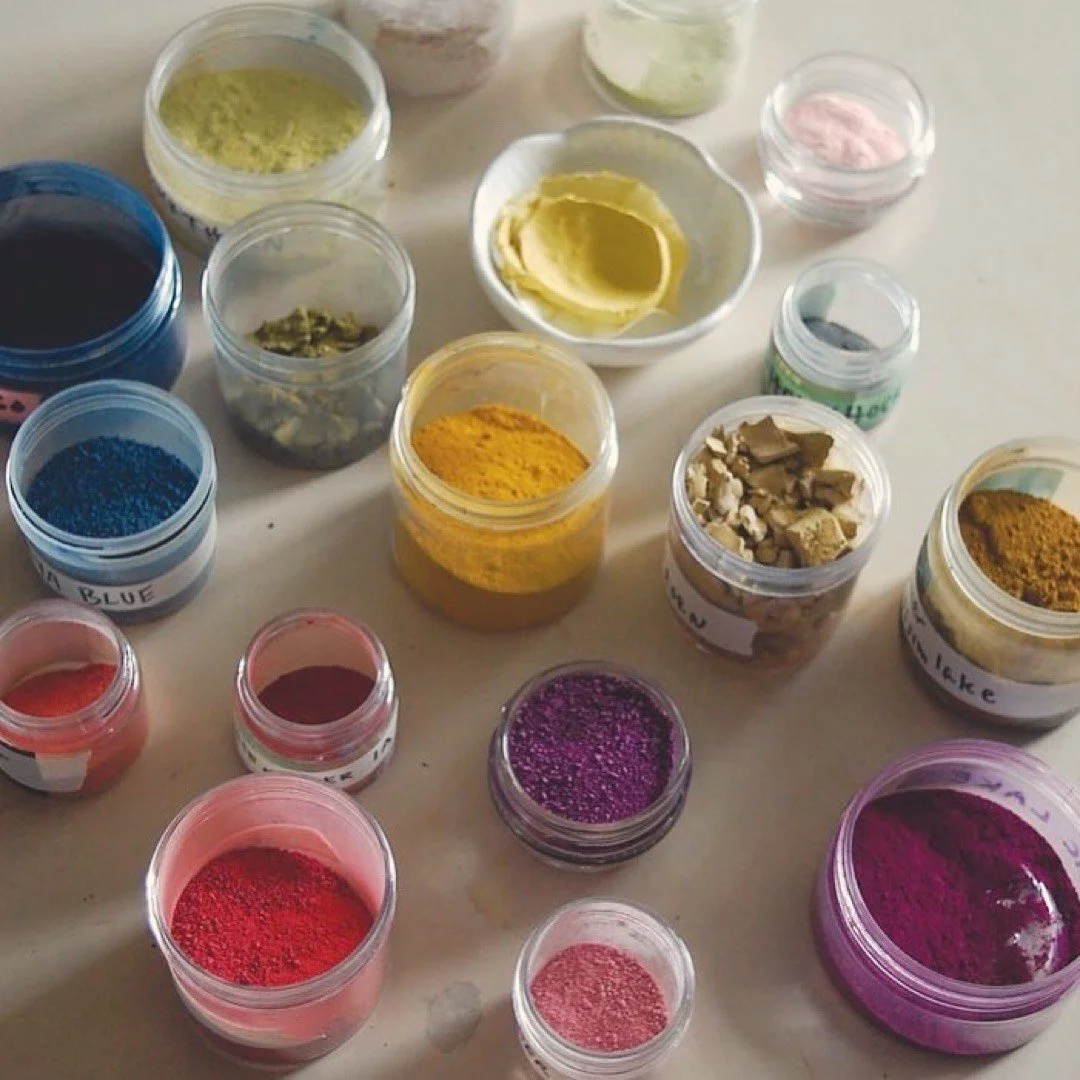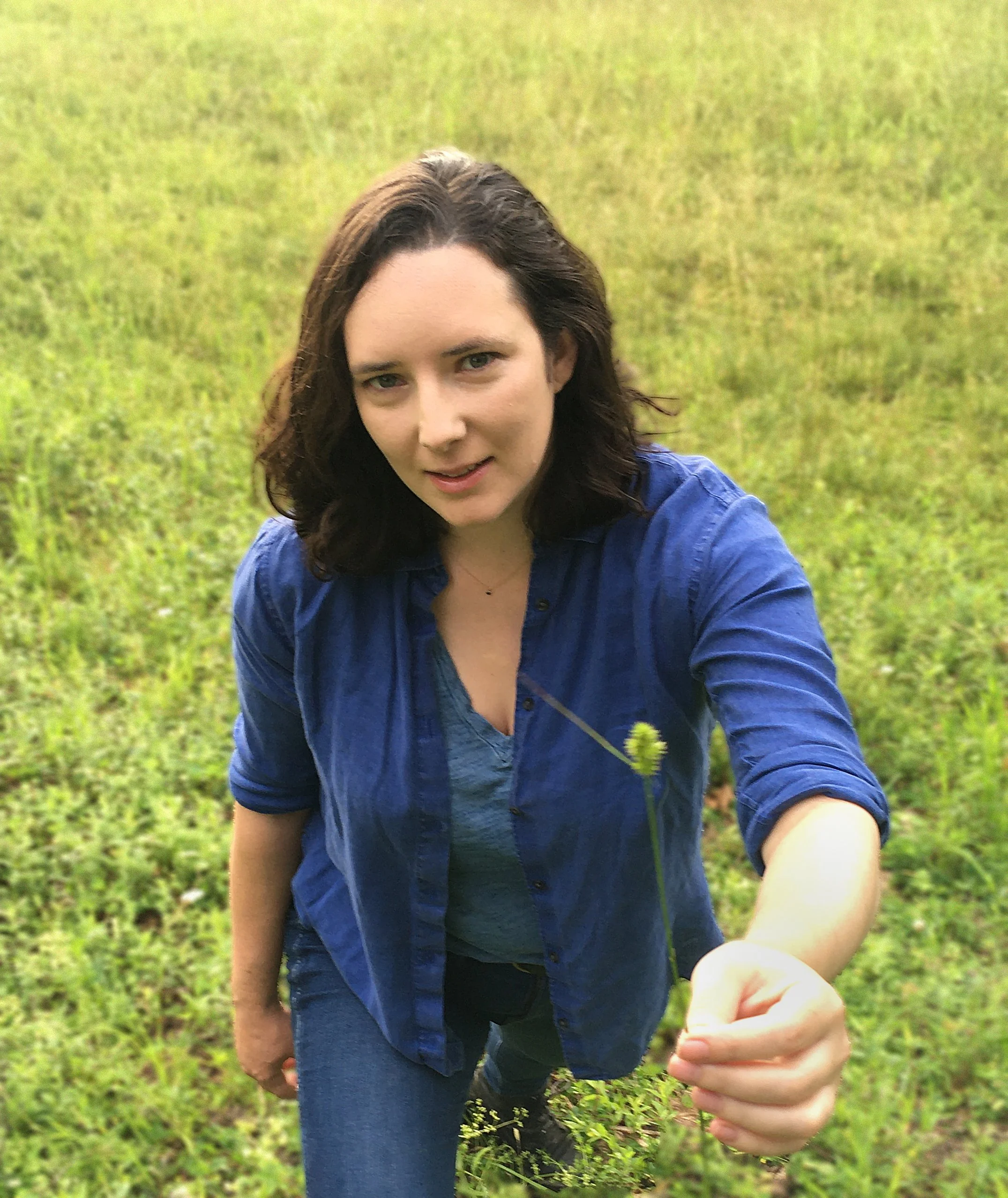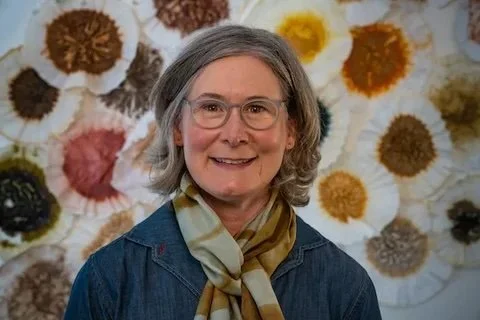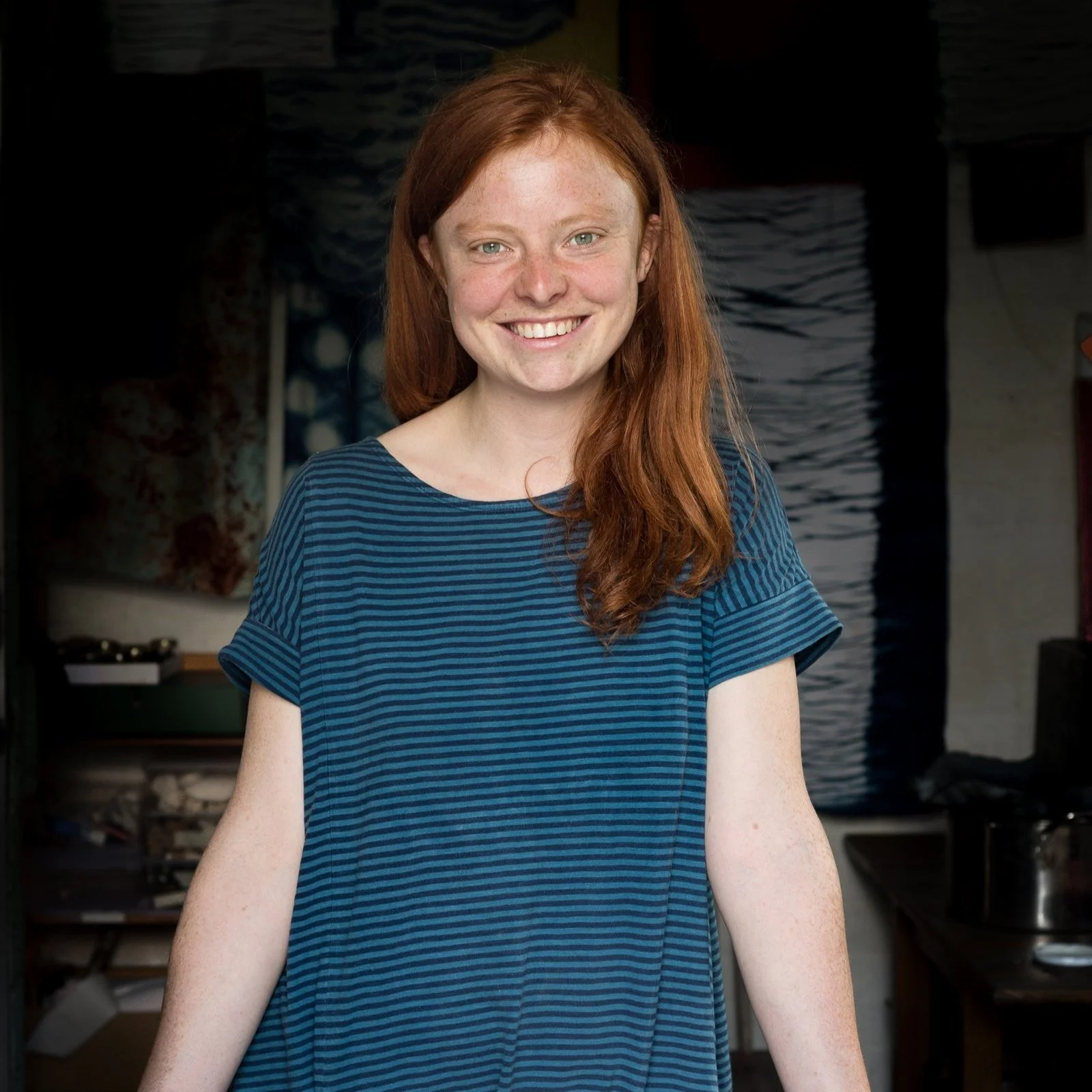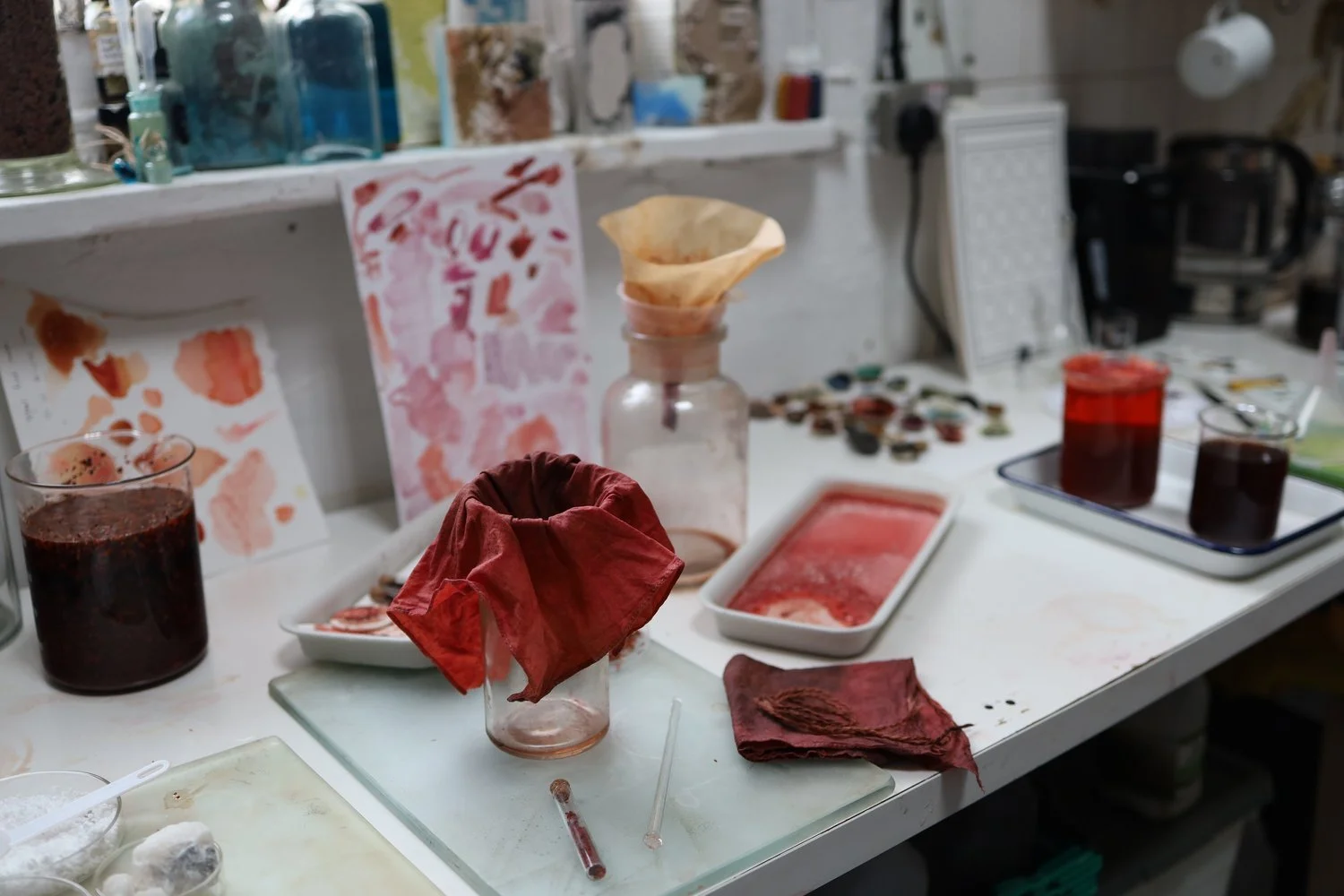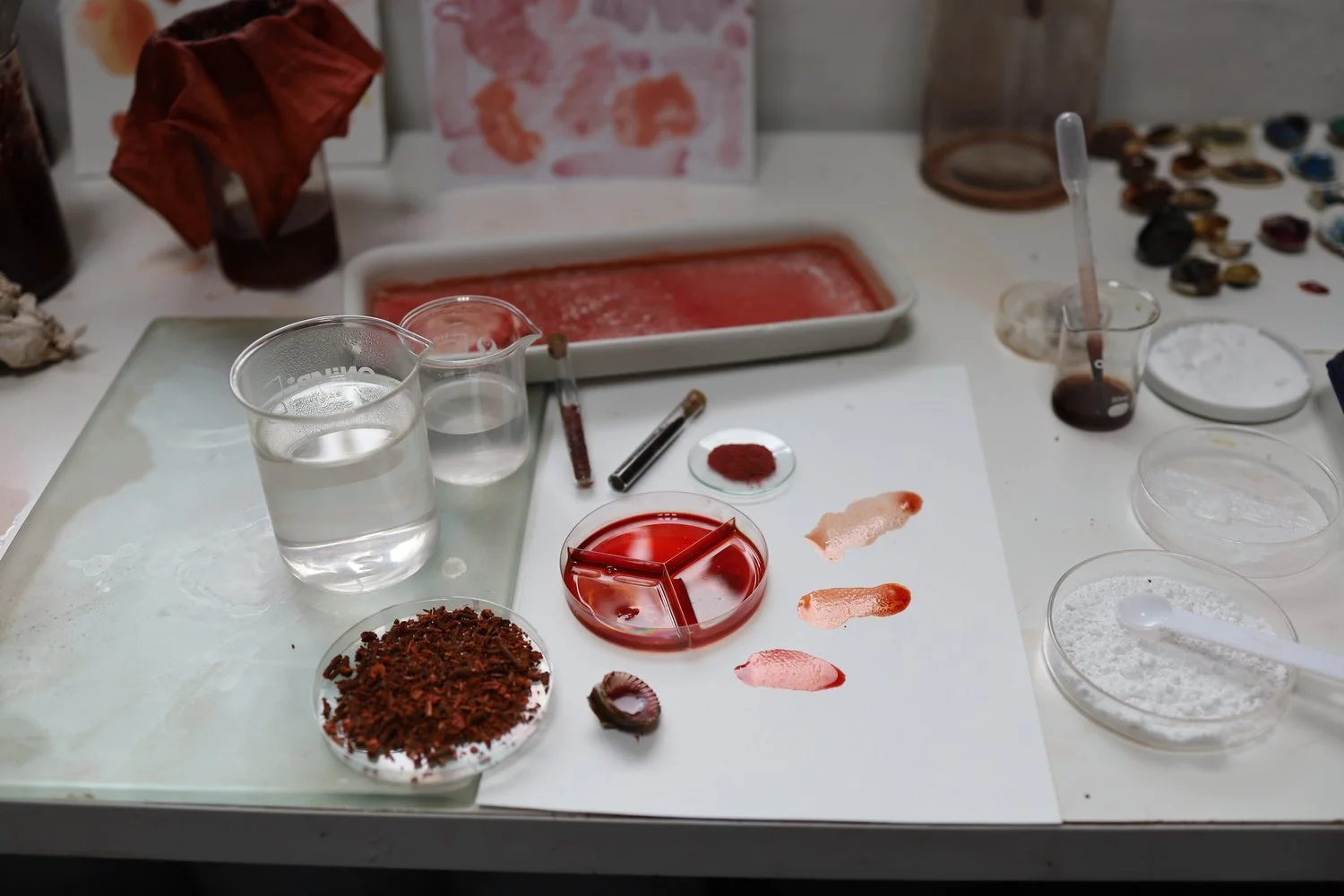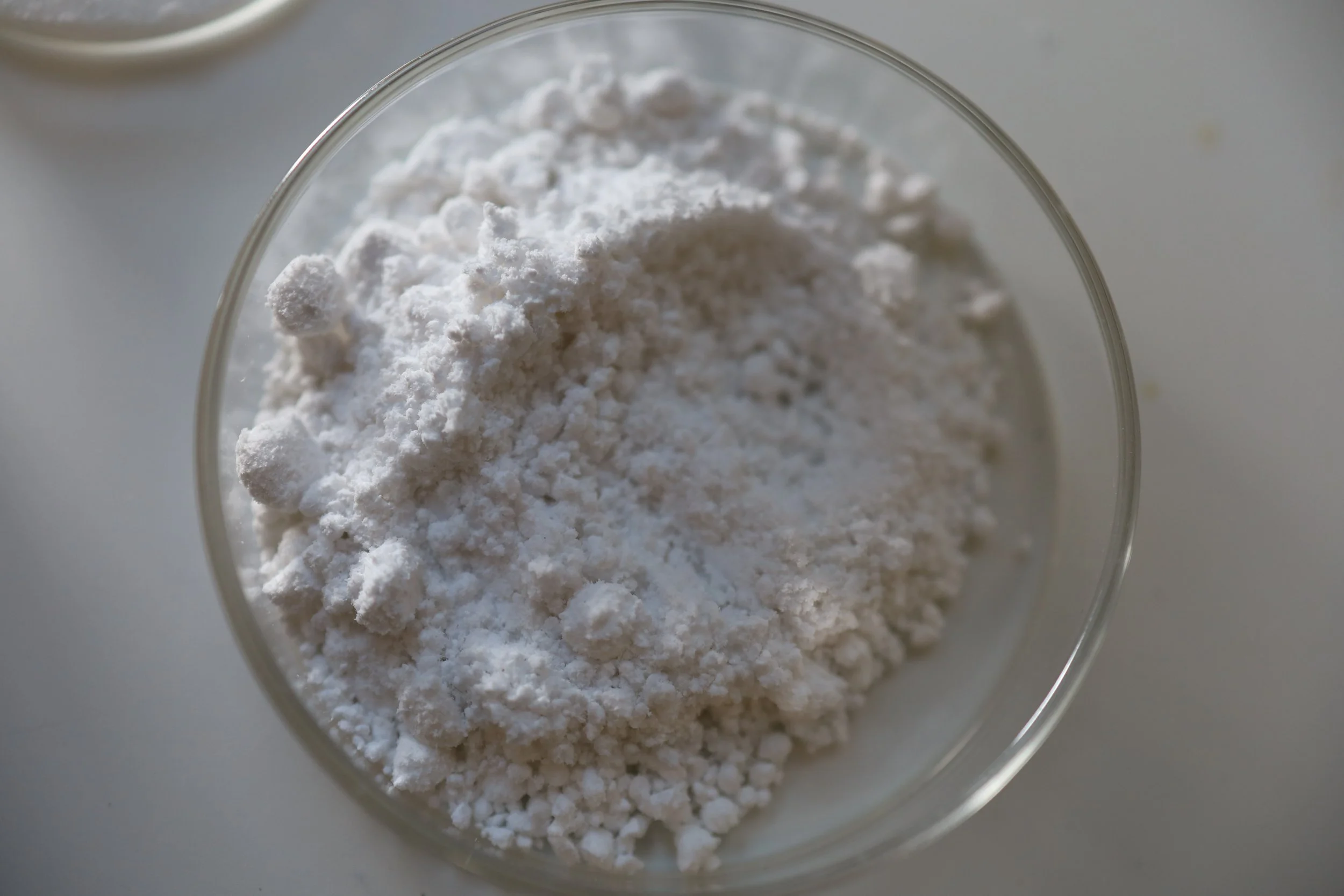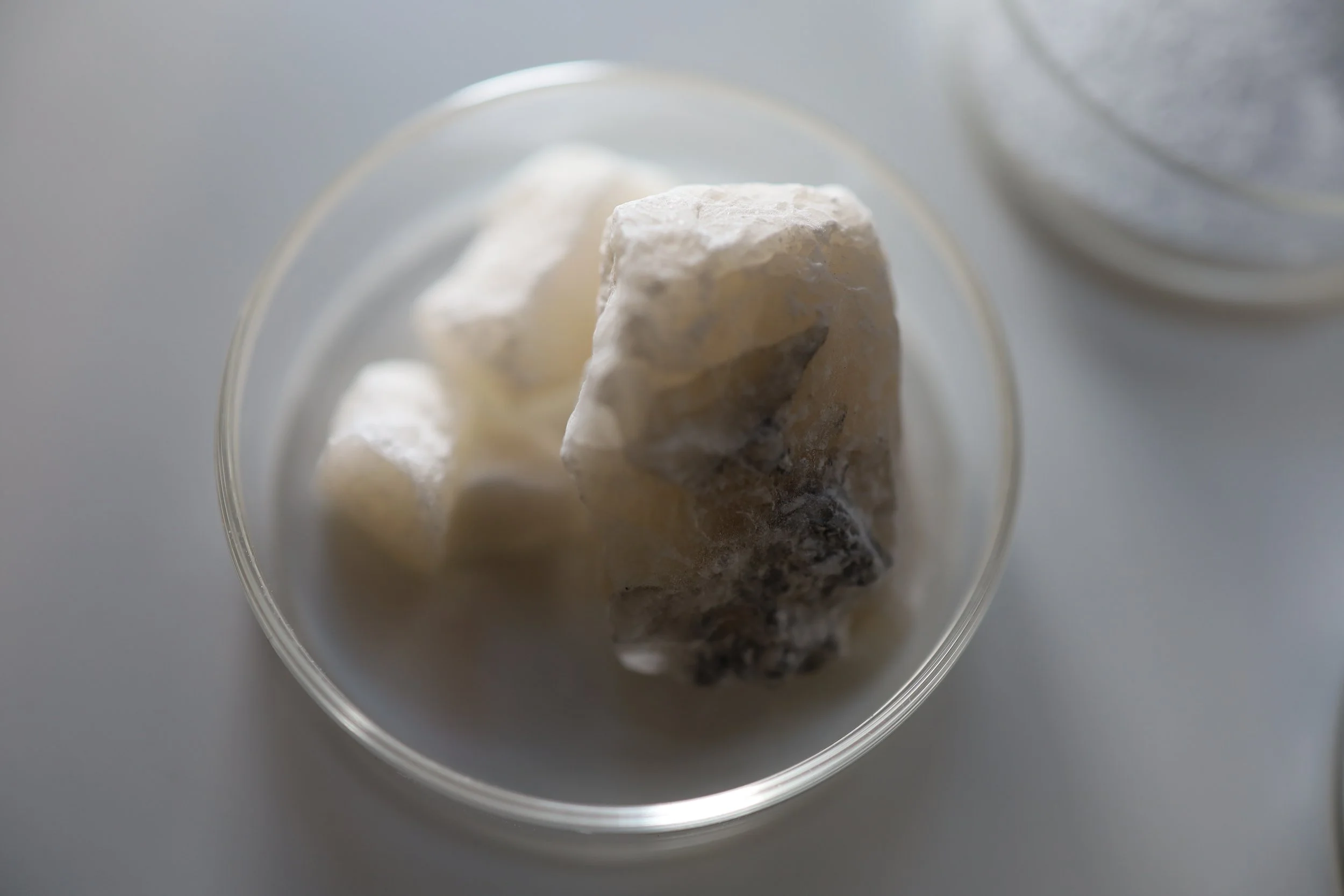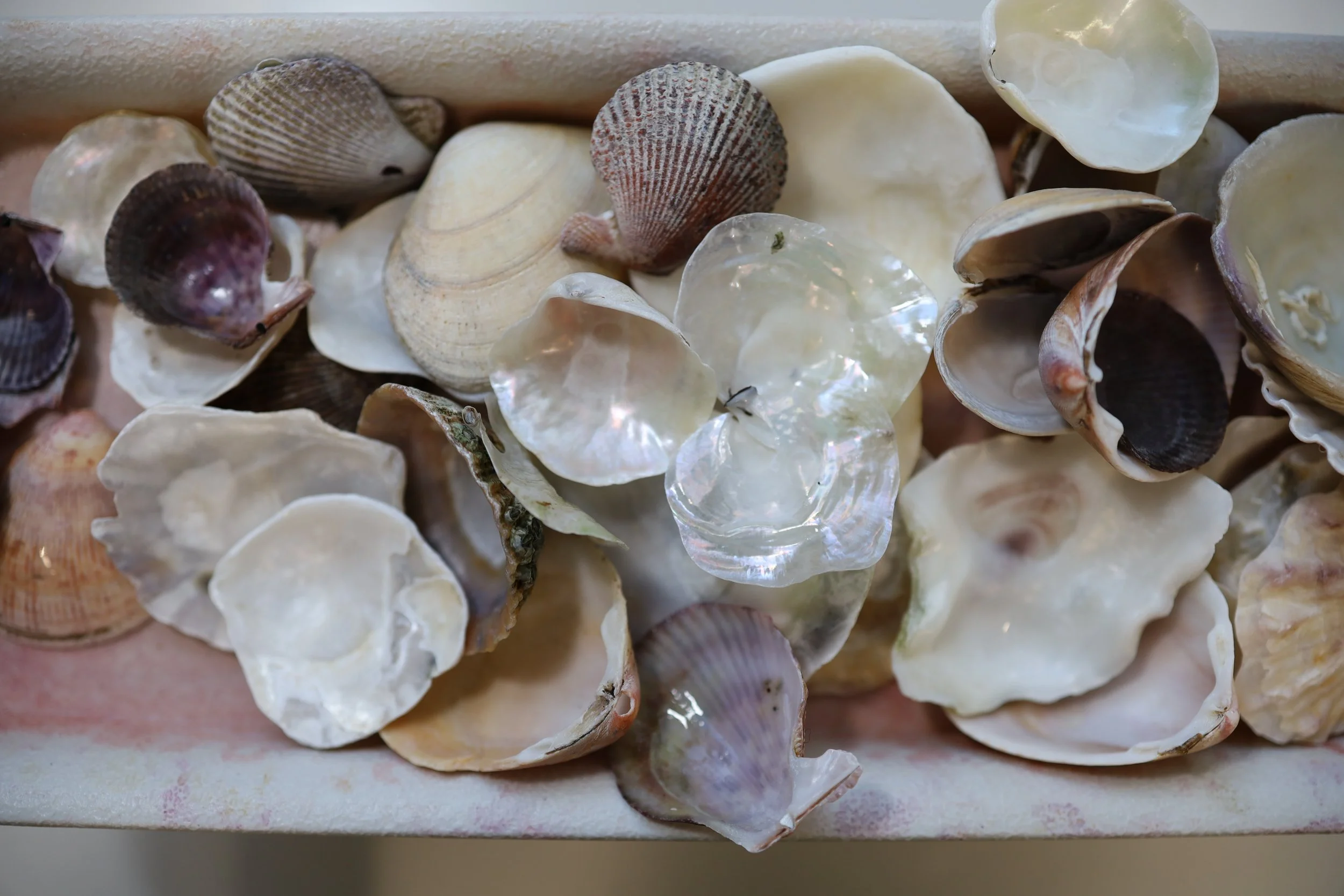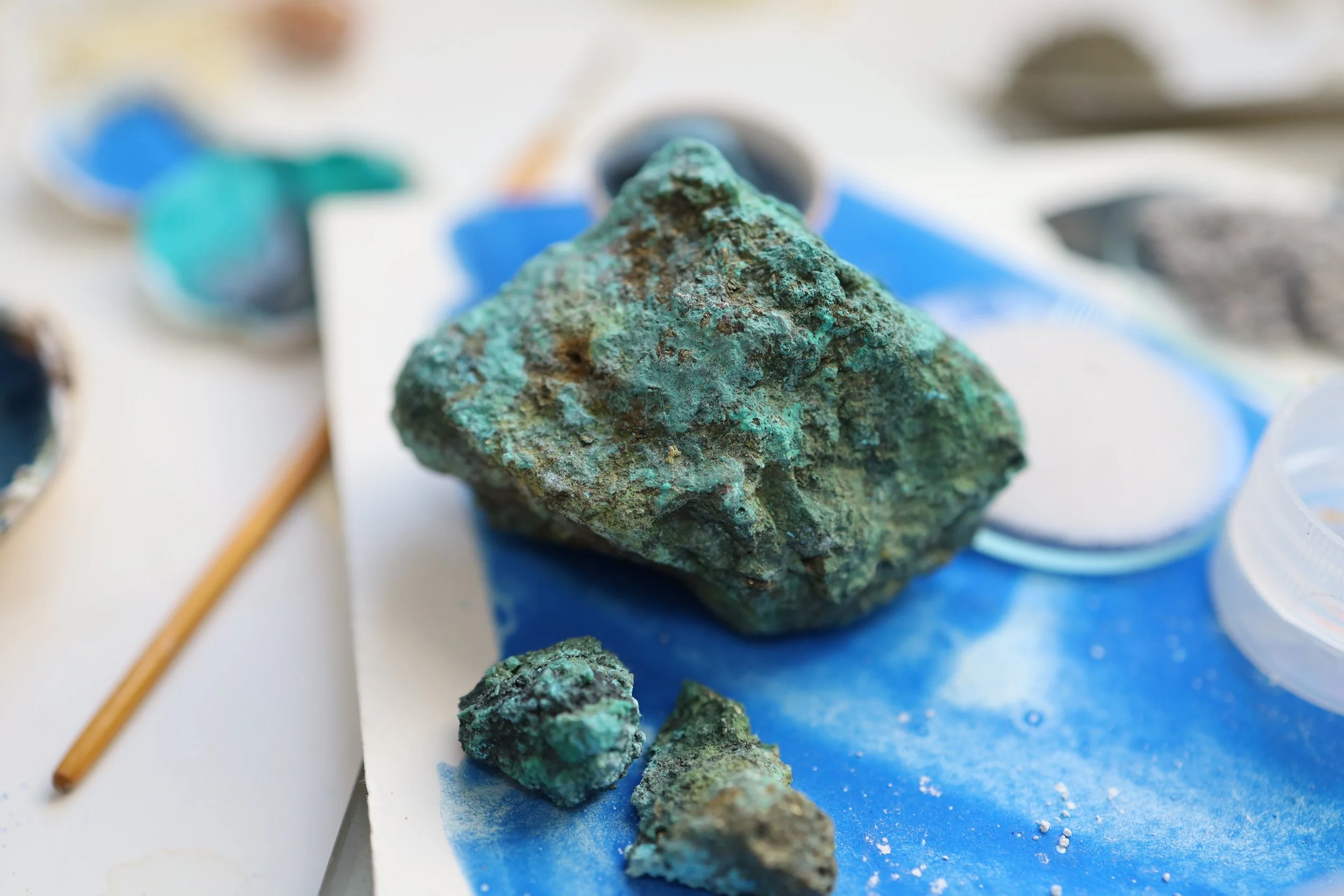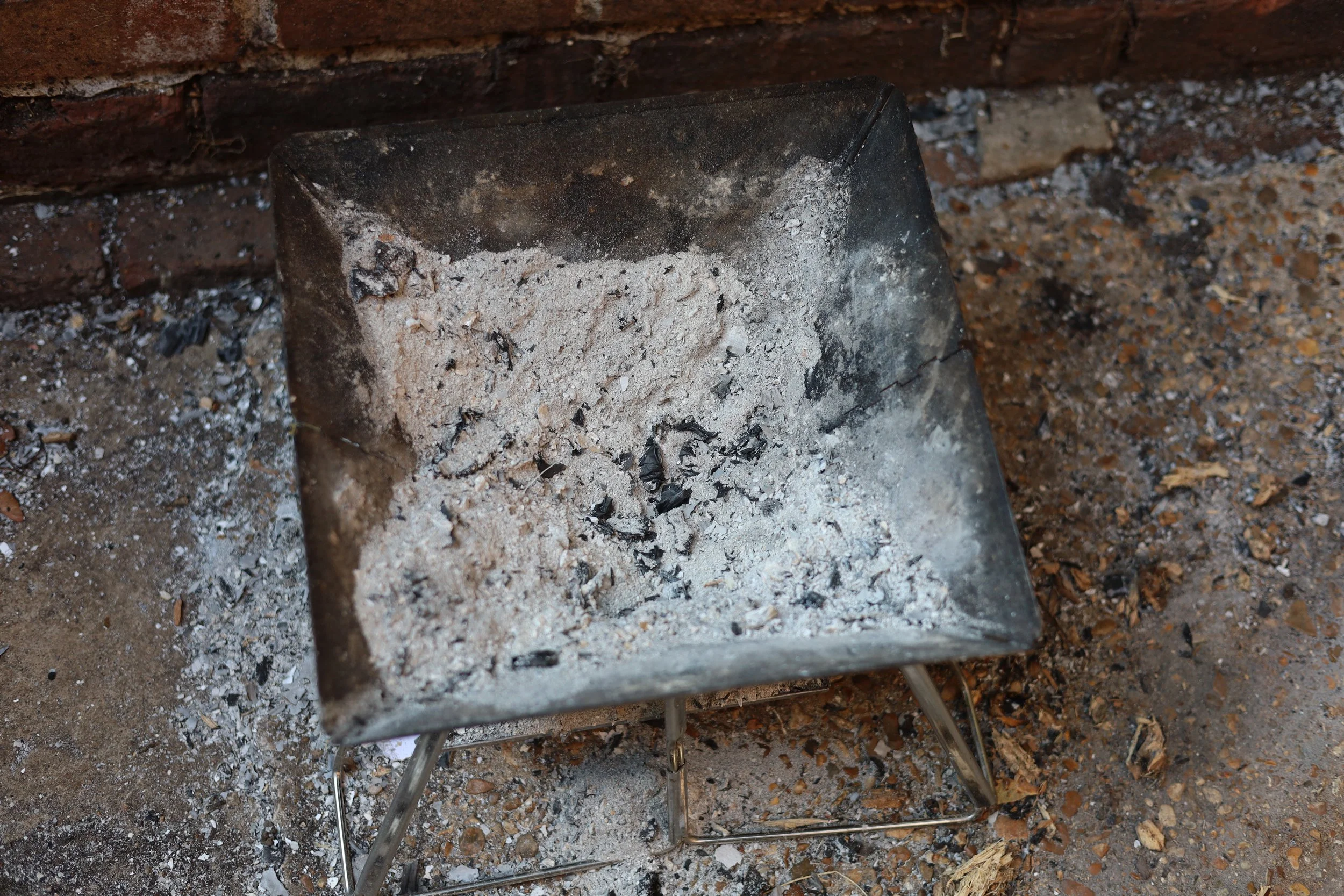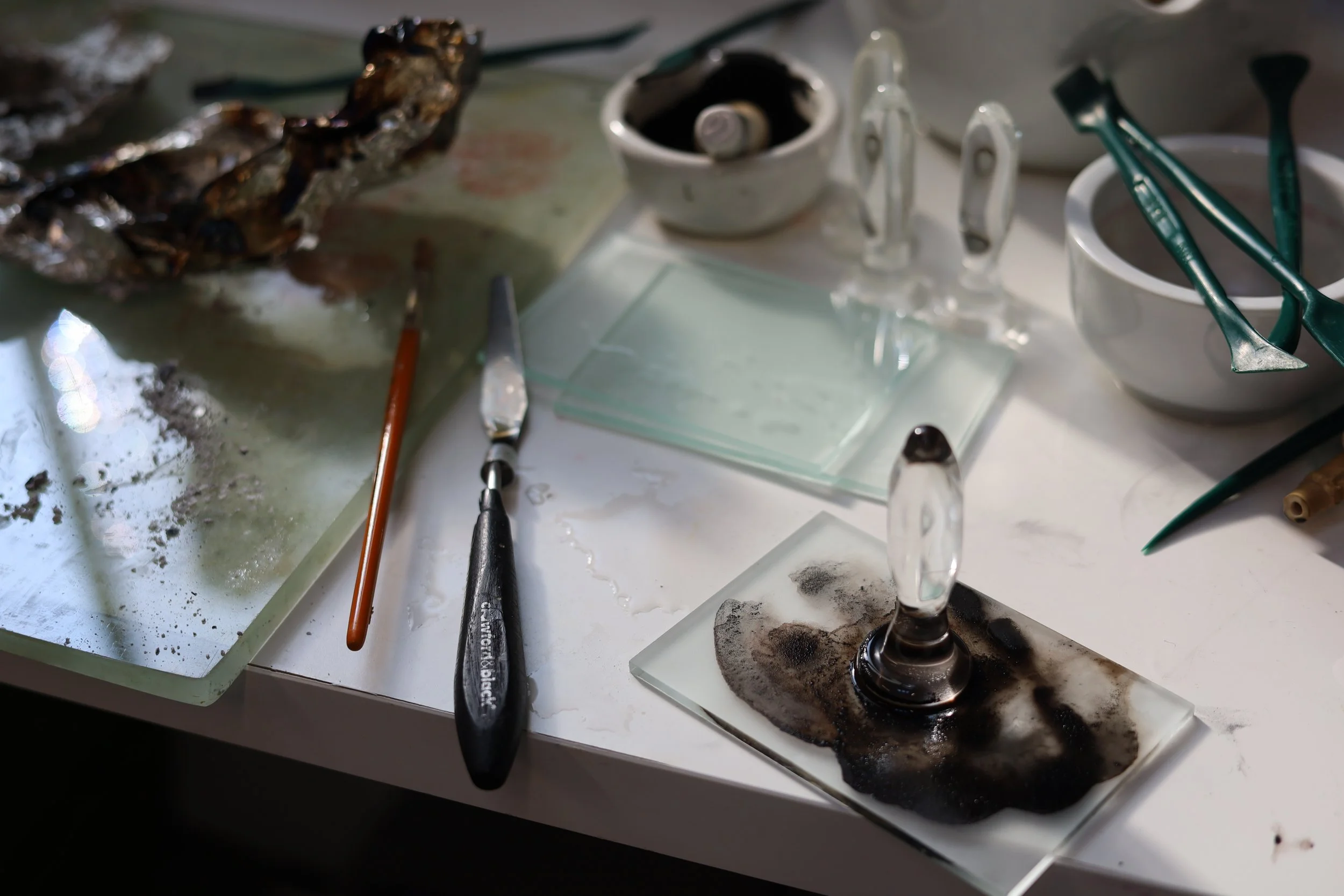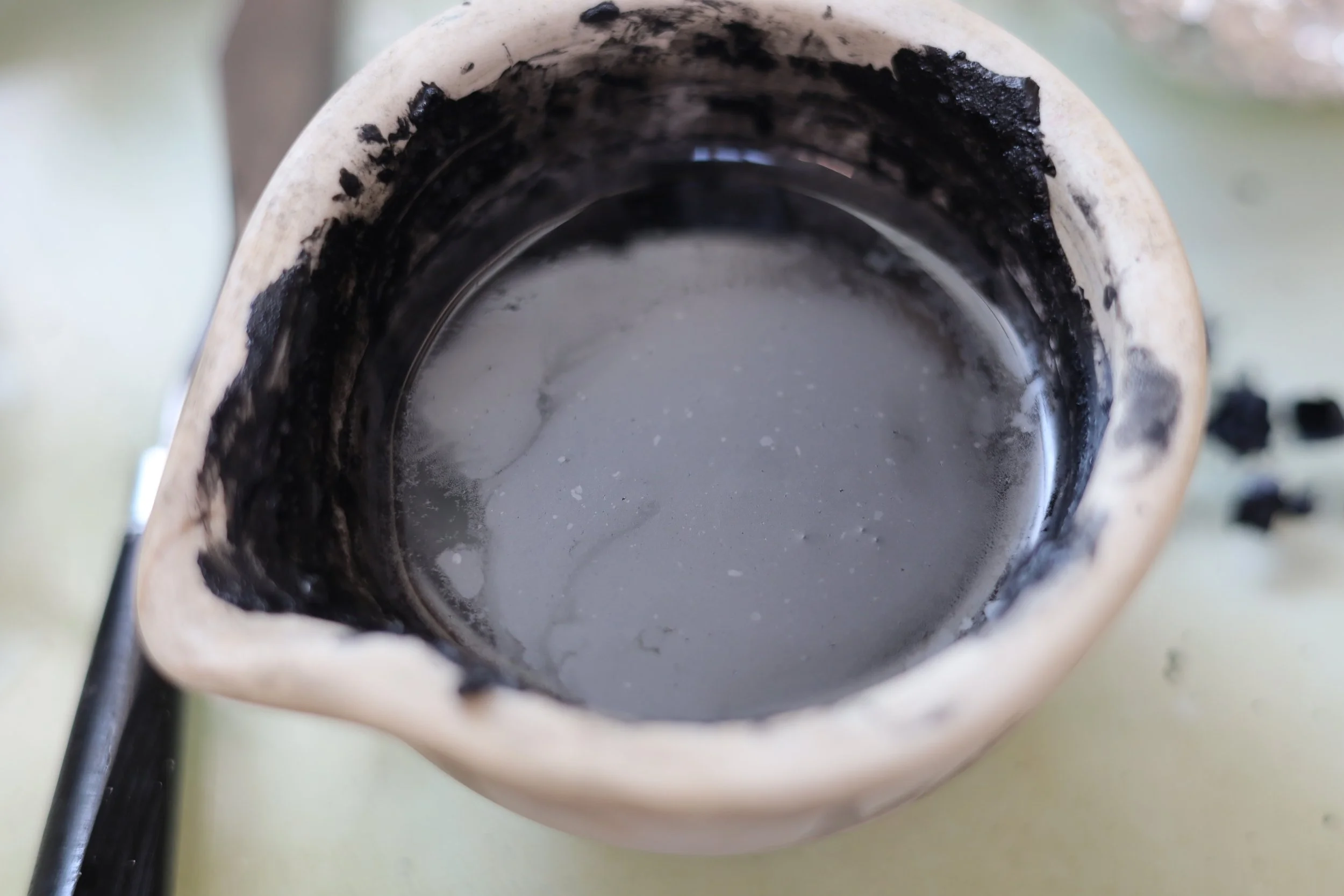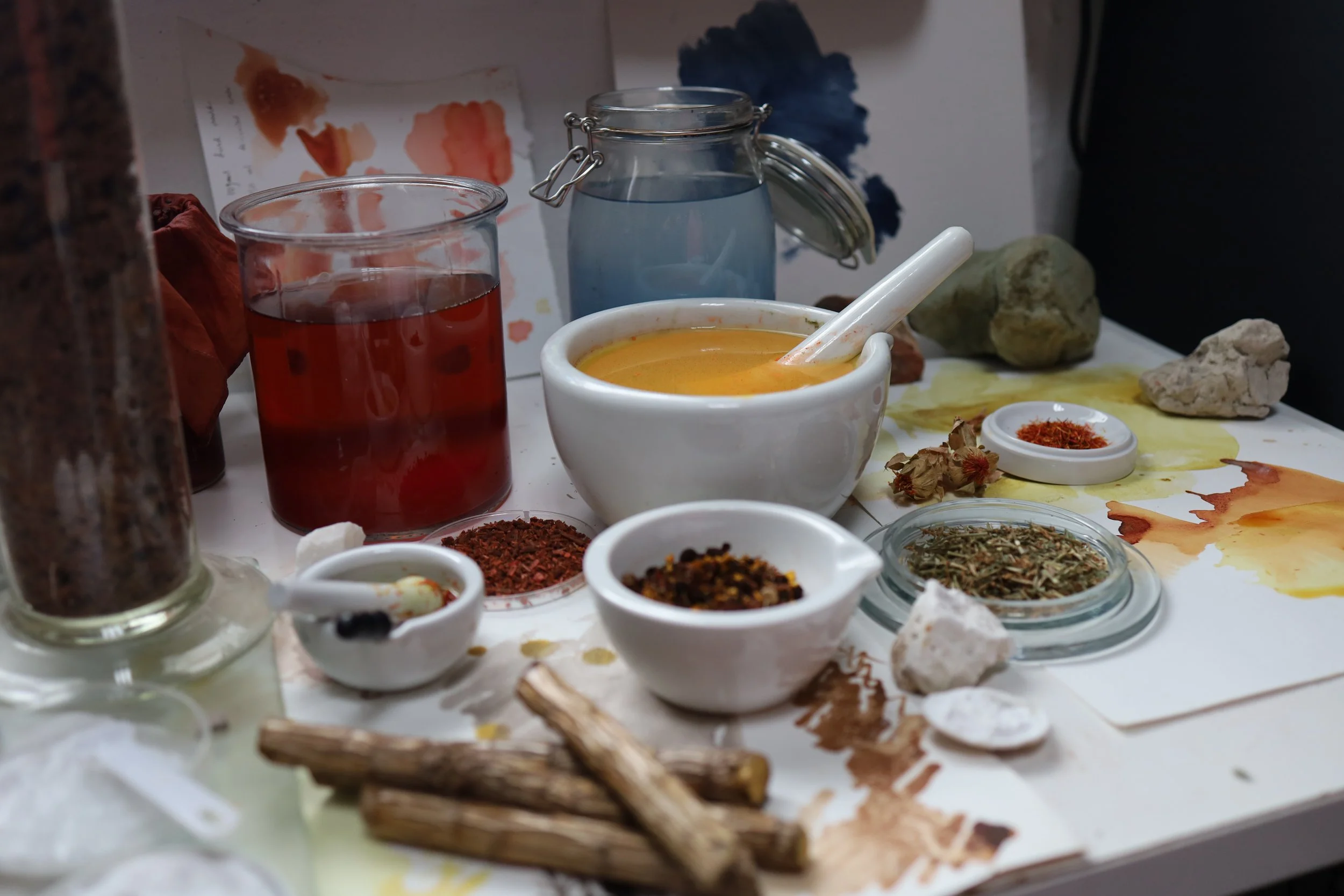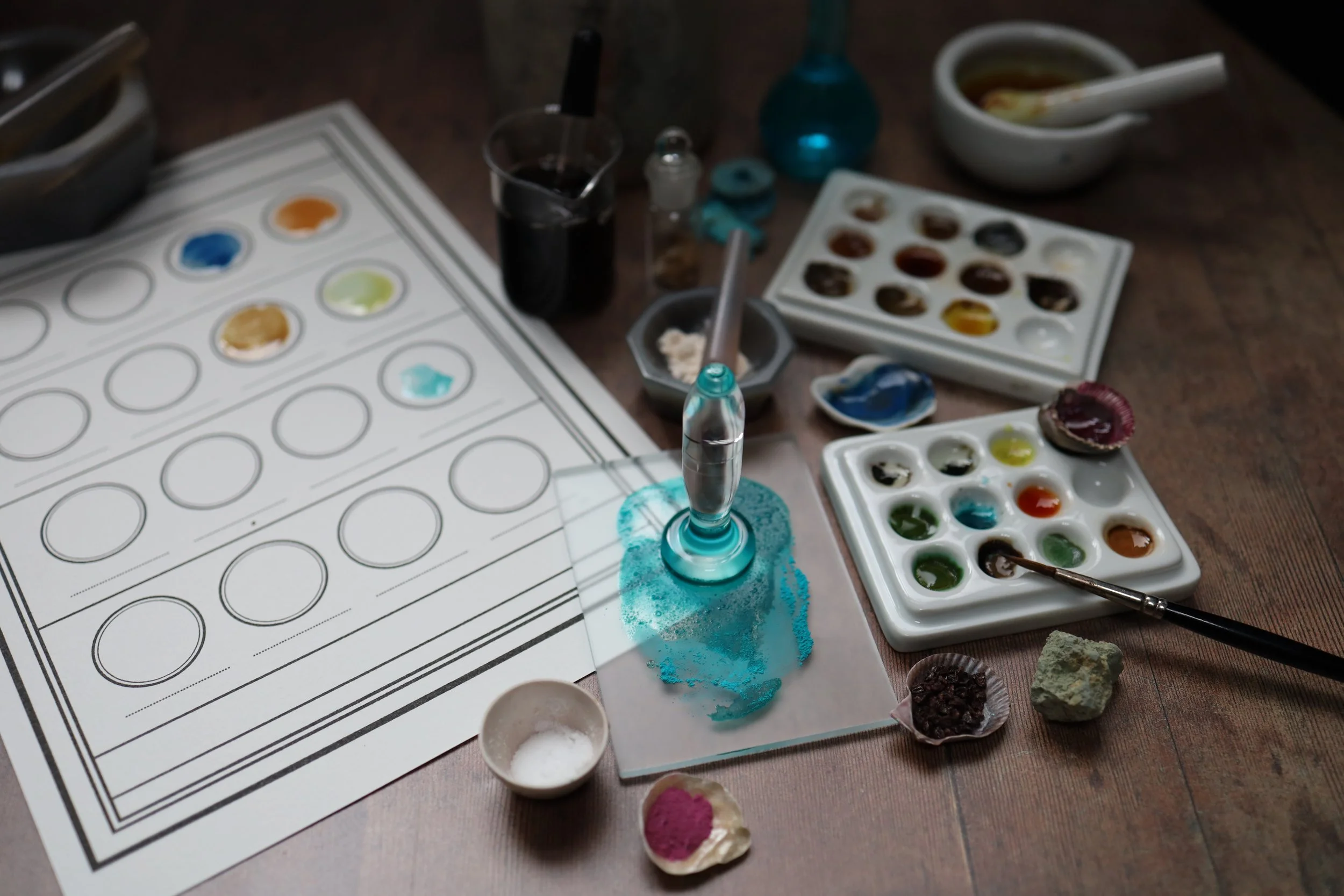A new yearlong online course starting in January 2026
Lake Pigment Making
A year long online programme exploring deeper into the history and chemistry of lake pigment making
Following a historical trajectory of making lake pigments from ancient Egyptian recipes, to medieval approaches, and modern day techniques. Taught by Natalie Stopka, Lucy Mayes, and Julie Beeler, leading monthly live online sessions covering different perspectives and processes for practicing this age-old approach to pigment making.
This course is aimed at those who have a basic understanding of lake pigment making and wish to delve deeper in to this practice.
In order to make the course accessible to beginners, we will put together a starter pack with a pre-recorded introduction to the basics of Lake Pigment making, a simple recipe with recommended plants & their quantities, and a glossary of terms so everyone can start on the same foundational knowledge and dive in deeper together.
This programme will include optional mentoring and focussed online study groups.
What is a Lake Pigment?
A lake pigment is an in-soluble powder pigment made by combining an organic dye with an inert binder, or mordant (usually a metallic salt).
Lake pigments can be used in printing inks, paints, and other artistic and decorative applications.
Course Summary:
Session One: Course Launch - Tuesday 13th January 2026, from 4-6pm GMT
Session Two: Historical & contemporary practices With Lucy Mayes - Tuesday 17th February 2026, from 4-6pm GMT
Session Three: Flowers of the Field With Natalie Stopka - Tuesday 17th March 2026, from 4-6pm GMT
Session Four: Sustainability With Lucy Mayes - Tuesday 21st April 2026, from 4-6pm BST
Session Five: Making Laking Reagents With Lucy Mayes - Tuesday 19th May 2026, from 4-6pm BST
Session Six: Buckthorn Lakes With Natalie Stopka - Tuesday 16th June 2026, from 4-6pm BST
Session Seven: Mushroom Lakes with Modifiers With Julie Beeler - Tuesday 15th July 2026, from 4-6pm BST
Summer Break
Session Eight: Indigo and other non-laked colourants With Natalie Stopka With Lucy Mayes contributing. - Tuesday 22nd September 2026, from 4-6pm BST
Session Nine: Madder Root Lakes With Natalie Stopka - Tuesday 13th October 2026, from 4-6pm BST
Session Ten: Fungi Alkali Extractions With Julie Beeler - Tuesday 3rd November 2026, from 4-6pm GMT
Session Eleven: Lichen Lakes With Julie Beeler - Tuesday 17th November 2026, from 4-6pm GMT
Session Twelve: Creating a Palette of Colours With Lucy Mayes - Tuesday 8th December 2026, from 4-6pm GMT
Session Thirteen: Closing Session - Tuesday 12th January 2026, from 4-6pm GMT
See session details below
Elements:
12 monthly live online sessions.
Opening and closing sessions with all the teachers.
A Starter Pack with a pre-recorded introduction to the basics of Lake Pigments, a simple recipe with recommended plants & their quantities, and a glossary.
Downloadable PDF handouts will be available for all techniques shared. With recipes & specific equipment & materials.
A reading list
An equipment & materials overview and guide
Online Study Groups and 1-1 mentoring from with Lucy Mayes and Natalie Stopka
Access:
All members will have access to the live sessions as well as the recordings in the member area on Plants & Colour Website. The resources will be available until December 2027, one year after the course is completed.
Time Commitments:
The live demonstrations will be two hours every month. You can either join live or watch the recordings in your own time.
In order to practice the techniques in your own time, this will require 6-12 hours per month of studio practice. The course is really what you make it. The more you can find the time to practice the techniques each month, you will get more from the course.
Meet the Team
Course Details
Introduction Session
13th January 2026
With All Teachers
In this live group session to launch the course, there will be introductions from the teachers and an overview of the course.
Covering the basics of what, why, and how of Lake Pigment Making.
We will be covering the introductory chemistry of lake pigment making as well as an overview of the history of the practice.
Looking at how you can set up a work space and what equipment and materials you will need to get started.
Historical & Contemporary Practices
17th February 2026
With Lucy Mayes
Putting Lake Pigments Into Context: An overview of creatives who have used lake pigments- alongside how lakes have been applied as a technology/applications e.g manuscript illumination, Renaissance glazing techniques
This session explores the use of lake pigments throughout history and into the present, highlighting how artists and craftspeople have engaged with them as both material and technology. Building on Part One—the introductory session in which Lucy offers an overview of the history of lake pigments—this session expands the timeline with contextual references and additional detail, providing a deeper understanding of how lake pigment-making evolved as a practical technology for artists seeking to work with local organic colour sources.
We’ll examine how lake pigments were used in various historical contexts, including manuscript illumination, Renaissance glazing techniques, textile dyeing, and even hair colouring. Particular attention will be given to their role in expanding colour palettes, creating layered visual effects, and enhancing surface quality.
The session will also introduce contemporary artists and makers who are reviving and reinterpreting lake pigment practices today, exploring how this ancient craft is being adapted within modern creative and ecological frameworks.
Flowers of the Field
17th March 2026
With Natalie Stopka
How can delicate and ephemeral flowers be transformed into lasting colors? This session will look at some of the methods that have been attempted, and the chemistry that makes them more or less successful. Pink, violet, and blue flowers will be our case study, demonstrating common pitfalls and confusion points when creating lake pigments: dye selection, pH manipulation, and lightfastness.
Proto-lakes from antiquity (Vitruvius & Eraclius) evolve into medieval lakes (Theophilus)
Hot water & ice extraction of anthocyanins
dye selection: substantive/adjective spectrum
What is pH, its role in laking, and effect on colour
Best practices for lightfastness
Can Making Lake Pigments Be More Sustainable?
21st April 2026
With Lucy Mayes
This is an in-depth examination of the common reagents used in laking; their sources, supply chains, and availability from suppliers and the industry. It also considers the environmental impacts of the process, including water and energy consumption. We will explore strategies to reduce or offset the environmental footprint of lake pigment production.
Additionally, we will evaluate the tools and equipment used in laking, focusing on sustainability, durability, and energy efficiency. Typical laking methods will be reviewed, with attention to how everyday practices can be adjusted to support more sustainable workflows. Specifically, we will closely examine the extraction, manufacture, and supply chains of key materials such as alum, distilled water, alkalis (e.g., sodium carbonate), fillers (like calcium carbonate and clays), and the organic dyestuffs themselves.
Making Laking Reagents
19th May 2026
How to create the essential components of lake pigments using accessible, natural materials.
With Lucy Mayes
Building on Part Four: Sustainability – Can Making Lake Pigments Be More Sustainable?, this session explores how to produce key laking reagents from scratch using low-impact, traditional methods. Alongside an overview of their historical use and production, participants will be guided through practical, replicable recipes.
We will make potassium carbonate by leaching, filtering, and evaporating plant ash, an alkali useful for creating lake pigments and adjusting pH in dye extraction and botanical inks. Sodium carbonate will be derived from burned seaweed (kelp), halophytic (salt-tolerant) plants, or by heating baking soda, serving as an important alkali in pigment precipitation.
Calcium carbonate will be produced by grinding oyster, mussel, or eggshells, with the option of gentle calcination (below 700°C) for purification. This material is used as a filler, extender, or base for lake pigments such as madder.
Aluminium salts (such as aluminium sulphate) will be sourced from food-grade materials or, for those interested in more advanced techniques, made by roasting clay with potassium salts or by processing aluminium-accumulating plants like common horsetail (Equisetum arvense). These salts serve as mordants and essential laking reagents. Iron salts will be created by soaking rusted iron in vinegar or rainwater to adjust tone and colour, and copper salts may also be introduced for further colour variation and experimentation.
This session emphasises practical, sustainable approaches to laking, using accessible materials and low-tech equipment, while fostering deeper material literacy and connection to historical craft. Broader material lifecycles will be explored, including the ecological pathways of the potassium cycle and the gradual sedimentation of calcium carbonate in ancient midden sites, revealing how natural and human-made processes shape the availability and transformation of key pigment-making materials over time.
Buckthorn Lakes
16th June 2026
With Natalie Stopka
We turn our attention this session to the ways that knowledge, recipes, and plants wander and proliferate. Our focus is buckthorn, a hedgerow plant that pops up in medieval recipes for sap green and spawns a variety of colors in later centuries, including lakes and ‘pinks’. Buckthorn eventually wanders not only through artists’ manuals and books of secrets, but also into new ecosystems. Because this is a designated invasive species in parts of North America, we’ll touch on plant varieties and substitutions, as well as ethical foraging guidelines more broadly. Building on the previous topics, this session will utilize homemade calcium carbonate and demonstrate tools of the medieval workshop.
Books of secrets & early modern laking
Invasive species & ethical foraging
Opaque lakes neutralized with chalk (pinkes)
Demonstrate medieval/early modern tools
Mushroom Lakes With Modifiers
15th July 2026
With Julie Beeler
In this session join Julie Beeler, creator of the Mushroom Color Atlas, for an immersive session exploring the art of making natural lake pigments from mushrooms. Using a single mushroom rich in diverse pigments, we’ll transform it into four distinct colours. Together, we’ll delve into techniques for working with exhausted dye baths, discuss the roles of substantive and adjective dyes, and aim to capture every ounce of colour. Through acidic extractions and simple dye bath modifications, you'll discover how one mushroom can yield a surprising spectrum of colour.
Indigo and Other Non-Laked Colourants
Tuesday 22nd September 2026, from 4-6pm BST
With Natalie Stopka
With Lucy Mayes Contributing
In the realms of natural colour, every rule has exceptions. This session delves into those intriguing, contrarian colourants which function as pigments by means other than laking. Segments on the hues of safflower, the gallo-tannin complex, murex purple, and a demonstration of indigo pigment extraction will illuminate these chemical oddities and expand our pigment palette.
Madder Root Lakes
Tuesday 13th October 2026, from 4-6pm BST
With Natalie Stopka
In the early 19th century, chemical analysis was brought to bear on colour-making processes, laying the path towards synthetic organic colors. European chemists grappled with the unique and expressive colours of madder root, vying to develop dozens of new, purer shades. This session will peek behind the curtain of that specialised (patented, commercialised) knowledge, before concocting some madder lake pigments that are open-source: fermentation is wild and free!
George Field, specialisation & privatisation of artisan knowledge
Effect of the revolution in scientific measurement and precision tools
Fermentation extraction
Demonstrate precision(ish) tools
Fungi Alkali Extractions
Tuesday 3rd November 2026, from 4-6pm GMT
With Julie Beeler
Curious about using mushrooms for color? Fungal pigments often require a shift in pH to reveal their full spectrum of hues. In this session, Julie Beeler—creator of the Mushroom Color Atlas—will guide you through alkaline extraction techniques for creating lake pigments from fungi. We’ll explore the traditional uses of Echinodontium tinctorium (commonly known as Paint Fungus), which has been used by Indigenous communities including the Syilx, Nlaka’pamux, Skwxwú7mesh (Squamish), and Kwakwaka’wakw for ceremonial body paint and medicinal purposes. According to research by Turner & Cuerrier (2021), the fungus was historically burned, ground into powder, and mixed with deer grease to produce a vivid burnt red pigment. Building on this knowledge, we’ll experiment with alkaline extractions that can also be applied to a range of organic materials—including plants, roots, bark, and food waste.
Lichen Lakes
Tuesday 17th November 2026, from 4-6pm GMT
With Julie Beeler
INFO COMING SOON
Creating a Palette of Colours
Tuesday 8th December 2026, from 4-6pm GMT
With Lucy Mayes
This session offers an overview of the wide range of hues that can be achieved through lake pigment making. By exploring both common and lesser-known historical recipes, we will examine the rich possibilities of building a full, nuanced palette from botanical and insect-based sources.
Together, we’ll examine historical laking methods in detail, exploring their unique characteristics, regional origins, and the practical challenges they present. Recipes covered will include carmine, Brazilwood, lac, logwood, weld, safflower (both yellow and red), quercitron, annatto, fustic, and kermes. Participants will gain insight into the colour qualities, stability, and uses of each pigment. We’ll work through a selection of these recipes from start to finish, while providing an overview of the remaining processes to build a comprehensive understanding of the broader laking palette.
We’ll also explore how to mix lake pigments, considering not only the aesthetic outcomes but also the implications for conservation, compatibility, and long-term durability. Whether you're aiming to reproduce a historical palette or develop your own contemporary range, this session will help you understand how lake pigments can be combined to create depth, harmony, and expressive potential.
Practice & Possibility
Tuesday 12th January 2027, from 4-6pm GMT
With All Teachers
In this closing session, we will be troubleshooting common mistakes and issues. We will give an overview of the applications of lake pigments, encouraging experimentation and innovation in laking and use of lakes. We will also make space for sharing work, reflections & feedback.

